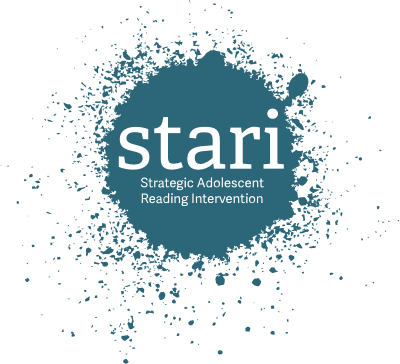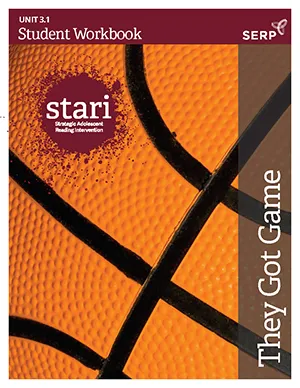By Kerry Friedman

The Strategic Adolescent Reading Intervention (STARI) is a literature-focused, Tier 2 intervention for students in grades 6 and up who read two or more years below grade level. Using research-based practices and highly engaging texts, STARI addresses gaps in fluency, decoding, reading stamina, and comprehension, aiming to move struggling students to higher levels of proficiency. STARI actively engages students in discussions of cognitively challenging content aligned to the Common Core and other 21st century standards.
Invent: Filling a Gap for Adolescent Readers

STARI was developed by the SERP Institute.
STARI was developed through a SERP Institute partnership with the Boston Public Schools that included researchers from Harvard and Wheelock College. The program was further developed and evaluated with a Reading for Understanding grant from the Institute of Education Sciences (IES). The partnership’s goal was to address a glaring need identified by Boston Public Schools: Students were arriving in high school without the reading comprehension skills to access grade-level content. While early elementary reading interventions were abundant, few evidence-based programs focused on older students who had mastered basic phonics but struggled with comprehension and fluency. Even fewer were designed with adolescent engagement in mind.
From its inception, STARI has been:
- Grounded in science: Targeting the interrelated skills of multisyllabic decoding, fluency, vocabulary, and comprehension.
- Shaped by practice: Co-designed and piloted by middle school teachers.
- Responsive to student psychology: Built around motivating, age-appropriate, and discussion-driven texts to counteract years of academic disengagement.
This commitment to research and responsiveness to teacher reality and student experience laid the foundation for a program that could be both effective and scalable. The gap in the market created the conditions for demand and adoption.
Apply: Testing and Improving the Intervention in Real Settings
— Margaret Troyer, director of Literacy Research & Development at SERP
Although small studies in a handful of classrooms were conducted during the early stages of development, the first efficacy evaluation of STARI took place during the 2013–14 school year. It yielded promising results, leading to STARI’s public release in 2014 and allowing STARI to expand to additional classrooms. Through its broader implementation and testing, it became clear that STARI’s design uniquely met the needs of older, struggling readers, who reported feeling motivated and newly successful in reading class. Students were engaged by high-interest novels with adolescent protagonists and were supported in understanding what they were reading and participating in rich conversation.
Teachers, in turn, became champions of STARI, appreciating that more engaged students meant fewer behavioral challenges and less resistance to reading. STARI’s status as an open educational resource (OER) allowed teachers and reading specialists to adopt it independently, often leading to grassroots diffusion and then teacher advocacy for further support and broader implementation within schools and districts.
Teacher engagement and additional evaluation grants for STARI drove iterative improvement. In a 2018–2022 Education Innovation and Research (EIR) mid-phase study, teachers provided feedback that led to major enhancements to usability and convenience, including streamlined lesson pacing, reorganization of units into clear grade-level tracks (grades 6–8), and improvements to formatting.
SERP Institute provided the organizational context for further scaling beyond research participants. SERP is an independent nonprofit organization wholly reliant on grants. It is composed of staff without faculty appointments to fall back on. This context required SERP to actively pursue the expansion of STARI in order to generate revenue to ensure the intervention’s sustainability.
For this reason, the SERP-led STARI team kept a keen eye on the market as a whole and how STARI could address further gaps. They found that districts needed interventions that spanned grades 6–12, not just middle school. In response, the team developed a series for high school, expanding STARI’s reach to grade 10 and beyond. They also found that many middle schoolers still lacked basic decoding skills, which adolescent-focused interventions did not address. So the team is working to develop STARI Boost, a computer-based phonics supplement, to fill this need while preserving dignity; students will use Boost during fluency practice time, avoiding public identification.
Transition: Scaling Through Strategic Adaptation and System-Building
Although STARI began as an open-access, teacher-driven intervention, the team recognized the need to transition from organic growth to strategic scaling. This involved building educator-facing and internal systems for scale, further leveraging STARI teachers and leaders as champions, and choosing strategic communication events and channels.
The STARI team won a series of U.S. Department of Education and private foundation grants that focused on testing, improving, and scaling evidence-based interventions. These grants enabled the team to enhance support for district and school ownership and sustainability of STARI implementation. With this funding, the team shifted professional development from in-person summer institutes to a comprehensive asynchronous model embedded across the school year. They also added supports for sustained district and school implementation, including a coach training system and revised assessment guides. In addition, the team leveraged these grants to expand STARI to more geographically diverse communities—for example, by recruiting study participants from rural districts and schools—and demonstrate STARI’s effectiveness across varied contexts.
SERP staff recognized that serving more schools requires streamlining sales and adoption processes, so they began focusing on how to better provide STARI at scale. They partnered with printers and book distributors to enable one-stop shopping, bundling curricular materials with novels and professional learning and building a web-based storefront and quote system to streamline district and school procurement. They also invested in video production and learning platforms that provided a polished and seamless teacher learning and implementation experience.
With scale came a need to systematically generate revenue to support operating costs. The primary source of revenue from STARI is professional development to help teachers effectively implement STARI. Schools and districts have the option to purchase annual licenses for teachers that will provide the recommended 24 hours of professional development through an online learning series. And while SERP’s current STARI offerings still allow teachers to freely download the curriculum materials and teacher lesson plans and to purchase the books on their own, the preprinted materials, bundled with the literature used in STARI, are available for direct purchase.
As scaling work continued, SERP staff learned that organic growth has its limits. Not having the capacity for endless cold calling, they turned their attention to strategic marketing and outreach. They used paid media, such as a successful Education Week webinar that generated nearly 1,000 leads, conference presentations and vendor booths, and an increased social media presence to build awareness. Across these channels, teacher voice and championing of the product have been at the forefront. In addition, SERP is steadfast in continuing to use feedback and engagement data from users to inform ongoing decisions about product marketing and user support.
Looking Forward
Today, STARI is scaling with a clear vision: to become self-sustaining, nationally known, and continuously responsive to teacher and student needs. It is expanding into geographically diverse districts and building the infrastructure to support long-term impact.
Key Takeaways

An example of the STARI Curriculum.
- Address a real, underserved need. STARI filled a major gap in the market: a research-based, engaging literacy intervention for older students reading below grade level. Identifying and directly addressing a neglected problem of practice can drive strong interest and organic uptake.
- Build something that students love. For students who have faced persistent challenges, engagement needs to be at the forefront of any academic intervention. STARI’s use of age-appropriate novels, relevant themes, and discussion-based comprehension reflects the central role of motivation in product effectiveness and scalability.
- Center teachers’ practical reality in design and development. Working closely with teachers and getting their feedback at every step of the way helped the STARI team address the practical constraints of real classrooms and the capabilities of typical educators, not just specialists. STARI’s developers proactively adjusted the curriculum based on classroom feedback, including restructuring unit pacing, adding lesson time estimates, and improving the layout of materials. Iterating on the delivery format, not just the content, was key to improving usability at scale.
- Let bottom-up adoption inform top-down strategy. Early growth came from enthusiastic teachers independently adopting the OER materials. Rather than immediately chasing large contracts, STARI built on this grassroots momentum by spreading within districts where they identified champions and then strategically engaged those champions to provide testimonials for marketing.
- Remain responsive to evolving needs. STARI expanded into high school, designed phonics support (STARI Boost), and adapted its training and product formats, all based on user feedback and district needs. Being adaptable helps retain relevance and meet broader market expectations (e.g., full grade 6–12 coverage).
- Build capacity for the transition to scale. The STARI team developed systems for material distribution, professional development, coach training, revenue generation, and user tracking. These structures are essential for sustaining a product beyond grant funding and research studies. As scaling progressed, the team added new expertise in, for example, video production, asynchronous learning design, and marketing. Knowing when to hire, partner, or build new capacity internally is critical.

Students and instructor using STARI in the classroom.
Published August 2025.
